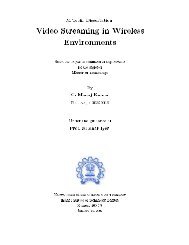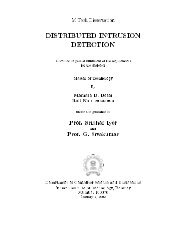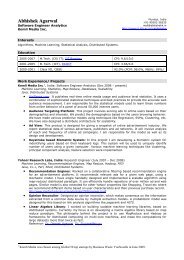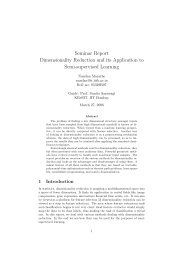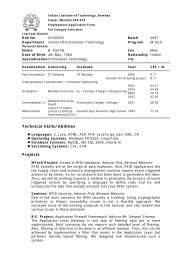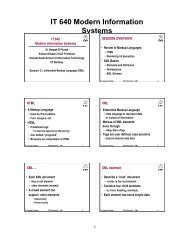A Method to Construct Counterexamples for Greedy Algorithms
A Method to Construct Counterexamples for Greedy Algorithms
A Method to Construct Counterexamples for Greedy Algorithms
You also want an ePaper? Increase the reach of your titles
YUMPU automatically turns print PDFs into web optimized ePapers that Google loves.
A <strong>Method</strong> <strong>to</strong> <strong>Construct</strong> <strong>Counterexamples</strong> <strong>for</strong> <strong>Greedy</strong><br />
<strong>Algorithms</strong><br />
ABSTRACT<br />
Jagadish M<br />
Dept. of Computer Science and Engg.<br />
Indian Institute of Technology Bombay<br />
Mumbai 400076, India<br />
jagadish@cse.iitb.ac.in<br />
Problem solving is the focus of any algorithm design course.<br />
Being able <strong>to</strong> construct counterexamples is a critical part<br />
of the problem solving process. We address the following<br />
question: Is there a teachable approach <strong>to</strong> construct counterexamples?<br />
We present a technique, called the Anchor<br />
<strong>Method</strong>, that could prove useful in constructing counterexamples<br />
<strong>for</strong> greedy algorithms. The basic idea of the method<br />
is <strong>to</strong> get insight about the structure of a counterexample by<br />
weakening the greedy algorithm. We show the applicability<br />
of the method by constructing counterexamples <strong>for</strong> some<br />
classic problems in graph theory. We also investigate the<br />
teachability of the technique through experiments.<br />
Categories and Subject Descrip<strong>to</strong>rs<br />
K.3.2 [Computers and Education]: Computer and In<strong>for</strong>mation<br />
Science Education<br />
General Terms<br />
<strong>Algorithms</strong><br />
Keywords<br />
<strong>Counterexamples</strong>, <strong>Greedy</strong> algorithms, Problem-solving<br />
1. INTRODUCTION<br />
In the design of algorithms, the discovery of a counterexample<br />
can help in discarding a wrong approach. <strong>Counterexamples</strong><br />
developed <strong>for</strong> failed approaches usually serve as test<br />
cases <strong>for</strong> new approaches and may also yield insight in<strong>to</strong> the<br />
problem structure.<br />
<strong>Construct</strong>ing counterexamples can be hard. Early research<br />
in cognition shows that people are more likely <strong>to</strong> look<br />
<strong>for</strong> examples <strong>to</strong> confirm a hypothesis than <strong>to</strong> disprove it[6].<br />
For example, it is common <strong>for</strong> students <strong>to</strong> come up with<br />
an intuitive (but wrong) algorithm and use input cases only<br />
<strong>to</strong> assure themselves of its correctness, instead of finding a<br />
rigorous proof or searching <strong>for</strong> a counterexample[3].<br />
Permission <strong>to</strong> make digital or hard copies of all or part of this work <strong>for</strong><br />
personal or classroom use is granted without fee provided that copies are<br />
not made or distributed <strong>for</strong> profit or commercial advantage and that copies<br />
bear this notice and the full citation on the first page. To copy otherwise, <strong>to</strong><br />
republish, <strong>to</strong> post on servers or <strong>to</strong> redistribute <strong>to</strong> lists, requires prior specific<br />
permission and/or a fee.<br />
ITiCSE’12, July 3–5, 2012, Haifa, Israel.<br />
Copyright 2012 ACM 978-1-4503-1246-2/12/07 ...$10.00.<br />
Sridhar Iyer<br />
Dept. of Computer Science and Engg.<br />
Indian Institute of Technology Bombay<br />
Mumbai 400076, India<br />
sri@iitb.ac.in<br />
<strong>Greedy</strong>, divide-and-conquer, recursion, dynamic programming,<br />
reduction, etc. are some of the prominent algorithm<br />
design techniques that are taught at undergraduate level.<br />
<strong>Counterexamples</strong> often crop up in the context of greedy algorithms.<br />
For example, every third exercise problem in the<br />
chapter on greedy algorithms in the Klienberg-Tardos textbook[5]<br />
requests <strong>for</strong> a proof or a counterexample. “Exchange<br />
argument” is often helpful in proving the correctness of a<br />
greedy algorithm. To the best of our knowledge, there is no<br />
method aimed at constructing a counterexample <strong>to</strong> disprove<br />
a greedy approach. Students simply rely on their intuition<br />
or search <strong>for</strong> counterexamples by trying small cases.<br />
We present a technique, called the Anchor method, that<br />
could prove useful in constructing counterexamples <strong>for</strong> greedy<br />
algorithms. We limit the scope of our work <strong>to</strong> simple greedy<br />
approaches since most of the problem solver’s first plans of<br />
attack tend <strong>to</strong> be greedy in nature. We also limit the scope<br />
of our problems <strong>to</strong> graph theoretic problems on unweighted<br />
graphs, since many problems in computer science map <strong>to</strong><br />
this class[8].<br />
In the next section, we introduce the notion of weak algorithm<br />
and define three types of counterexamples: weak,<br />
plausible and definitive. We will use the Maximum Independent<br />
Set (MIS) problem as a running example <strong>to</strong> clarify<br />
these definitions and also illustrate the working of the anchor<br />
method (section 3). In section 4, we use the anchor<br />
method <strong>to</strong> construct counterexamples <strong>for</strong> a few well-known<br />
problems in graph theory–this shows the general applicability<br />
of our method. In section 5, we address questions related<br />
<strong>to</strong> the teachability of the method.<br />
2. DEFINITIONS<br />
Weak Algorithm. The greedy algorithm works by ‘making<br />
the choice that looks best at the moment’ [5]. We define<br />
a weak algorithm <strong>to</strong> be an algorithm that works by making<br />
an arbitrary choice at each moment.<br />
Weak Counterexample. A weak counterexample is an<br />
instance on which the weak algorithm fails assuming the<br />
worst possible execution or, in other words, when choices<br />
are made in an adversarial manner (e.g. Fig. 4).<br />
Plausible and Definitive Counterexample. If more<br />
than one choice looks best at a given step, the greedy algorithm<br />
makes a choice non-deterministically. Hence, the<br />
algorithm could have multiple execution paths <strong>for</strong> a given<br />
input instance. We call an input instance a plausible counterexample<br />
if one of the execution paths leads <strong>to</strong> a wrong<br />
answer. Similarly, an input instance is called a definitive
counterexample if every possible path of execution leads <strong>to</strong><br />
a wrong answer.<br />
Maximum Independent Set Problem<br />
A graph G consists of a set V of vertices and a set E of pairs<br />
of vertices called edges. For an edge e = (u, v), we say e is<br />
incident on vertex u and v; vertices u and v are also the<br />
endpoints of e. The pair of vertices in an edge is unordered<br />
so e = (u, v) is the same as e = (v, u). The degree of a vertex<br />
is the number of edges incident upon it.<br />
Problem. Let G = (V, E) be an graph. The maximum<br />
independent set problem (MIS) is <strong>to</strong> find the largest vertex<br />
set S ⊆ V such that no two vertices in S have an edge<br />
between them in E. See Fig. 1.<br />
e<br />
a<br />
d<br />
b<br />
Figure 1: In the graph shown, S = {a, c} is a maximum<br />
independent set.<br />
Consider the following greedy approach <strong>to</strong> solve the MIS<br />
problem:<br />
Algorithm. When a vertex is picked, we are prohibited<br />
from picking its neighbors. Since we want <strong>to</strong> pick as many<br />
vertices as possible, we start by picking vertices with low<br />
degree[7].<br />
Algorithm 2.1: MIS(G)<br />
Input: Graph G<br />
Output: An independent set S from graph G<br />
Initially the set S is empty.<br />
1 : Sort the vertices according <strong>to</strong> their degree.<br />
Let V s be the sorted sequence.<br />
2 : <strong>for</strong> each vertex v in V s<br />
if vertex v does not have a neighbor in S<br />
add vertex v <strong>to</strong> set S.<br />
3 : Report S as the answer<br />
Consider the input graph in Fig. 2: a cycle of length 6<br />
(C 6). The size of the maximum independent set in this<br />
graph is 3 (set {a, c, e} <strong>for</strong> example).<br />
a<br />
f<br />
b<br />
Figure 2: Cycle C 6 has 3 independent vertices.<br />
As all the degrees of vertices are same, the algorithm could<br />
sort them in any order. If V s = [a, b, c, d, e, f], the algorithm<br />
returns {a, c, e} as the maximum independent set. However,<br />
if V s = [a, d, f, e, b, c], the algorithm returns {a, d} as the<br />
maximum independent set (incorrectly). Hence the input<br />
graph C 6 is a plausible counterexample <strong>for</strong> the given greedy<br />
algorithm.<br />
In general, we can convert a plausible counterexample in<strong>to</strong><br />
a definitive counterexample with some modification. In the<br />
e<br />
c<br />
d<br />
c<br />
above example, we want the algorithm <strong>to</strong> pick vertices a and<br />
d be<strong>for</strong>e others. We can ensure that by adding the edges<br />
(b, e) and (c, f) as shown in Fig. 3.<br />
a<br />
f<br />
b<br />
e<br />
c<br />
d<br />
⇒<br />
Figure 3: Converting a plausible counterexample <strong>to</strong><br />
a definitive counterexample. The size of the MIS<br />
in the second graph is 3 ({a, c, e}), but the greedy<br />
algorithm 2.1 always returns a set of size 2 ({a, d}).<br />
Although a definitive counterexample is more desirable,<br />
providing a plausible counterexample is a legitimate way of<br />
disproving a greedy algorithm.<br />
3. WORKING OF THE ANCHOR METHOD<br />
Our objective is <strong>to</strong> construct a counterexample <strong>to</strong> a given<br />
greedy algorithm. The anchor method follows a basic principle<br />
of problem-solving: solve an easier problem first. Instead<br />
of constructing a greedy counterexample directly, we first<br />
construct a counterexample <strong>for</strong> the weak algorithm. We call<br />
this a weak counterexample. Recall that a weak algorithm is<br />
obtained from the greedy algorithm by replacing the greedy<br />
choice with an arbitrary choice. The assumption is that the<br />
weak counterexample gives insight in<strong>to</strong> the structure of the<br />
greedy counterexample. Our method consists of two steps:<br />
Step 1 Build an anchor Use the weak counterexample<br />
<strong>to</strong> obtain an anchor. The anchor is a skele<strong>to</strong>n that<br />
captures the essence of a possible greedy counterexample.<br />
It serves as a starting point <strong>for</strong> constructing a<br />
counterexample <strong>to</strong> the greedy algorithm.<br />
Step 2 Add an auxiliary structure Attach an auxiliary<br />
structure <strong>to</strong> the anchor <strong>to</strong> obtain a complete counterexample.<br />
The purpose of the auxiliary structure is<br />
<strong>to</strong> ensure that the greedy algorithm essentially mimics<br />
the weak algorithm (and hence fails in the same<br />
way). Auxiliary structures usually have ‘extreme’ or<br />
‘common’ structures.<br />
We apply the anchor method <strong>to</strong> construct a counterexample<br />
<strong>to</strong> Alg. 2.1 <strong>for</strong> the MIS problem. This algorithm picks the<br />
vertices in increasing order of degree, so the corresponding<br />
weak algorithm picks vertices in arbitrary order.<br />
3.1 Maximum Independent Set: An illustrative<br />
example<br />
Building an Anchor. Consider the weak algorithm that picks<br />
the vertices in arbitrary order <strong>to</strong> include in S. A counterexample<br />
<strong>to</strong> this algorithm is shown in Fig. 4.<br />
The weak algorithm could pick the central vertex first<br />
and get an independent set of size 1, whereas the maximum<br />
independent set has size 3 ({a, b, c}). So this is our weak<br />
counterexample.<br />
In the weak counterexample, the central vertex has the<br />
highest degree. We know that the greedy algorithm would<br />
pick the central vertex in the above graph first if the central<br />
a<br />
f<br />
b<br />
e<br />
c<br />
d
c<br />
a<br />
b<br />
1 2 n<br />
. . .<br />
Figure 4: A counterexample <strong>to</strong> the weak algorithm<br />
<strong>for</strong> the MIS problem. A star graph with three outer<br />
vertices.<br />
K n<br />
vertex had the lowest degree somehow. The anchor just<br />
captures this intuition (Fig. 5).<br />
Notation. We use symbols and <strong>to</strong> indicate a vertex<br />
we wish were of high degree and low degree, respectively.<br />
Figure 7: A general counterexample <strong>to</strong> Alg. 2.1 <strong>for</strong><br />
the MIS problem with O(n) approximation ratio.<br />
The greedy algorithm picks 2 independent vertices,<br />
while the optimal algorithm picks n vertices.<br />
graph K n <strong>to</strong> the corresponding anchor gives us a general<br />
counterexample (Fig. 7) with the best approximation ratio.<br />
We may have <strong>to</strong> try a few weak counterexamples be<strong>for</strong>e<br />
hitting upon the one which extends <strong>to</strong> a greedy counterexample.<br />
Figure 5: The anchor obtained from the weak counterexample.<br />
Adding the auxiliary structure. Each high degree vertex<br />
needs <strong>to</strong> be connected <strong>to</strong> at least 3 vertices in order <strong>to</strong> exceed<br />
the low degree central vertex. Let K n denote a complete<br />
graph with n vertices. Attaching the auxiliary graph K 3<br />
gives a counterexample as shown in Fig. 6.<br />
c<br />
K 3<br />
Figure 6: A counterexample <strong>to</strong> Alg. 2.1 <strong>for</strong> the MIS<br />
problem. A dark edge indicates that there are edges<br />
from the high degree vertex <strong>to</strong> all the three vertices<br />
in K 3. The central vertex has degree 3. Vertices a, b<br />
and c have degree 4 each. Each vertex in K 3 has<br />
degree 5. So the greedy algorithm picks the central<br />
vertex first and then picks one vertex from K 3.<br />
The maximum independent set is actually {a, b, c}.<br />
Hence, the greedy algorithm picks 2 vertices, while<br />
the optimal algorithm picks 3.<br />
Approximation ratio. The approximation ratio is a<br />
measure of how good a counterexample is. It is defined<br />
as follows: Suppose I is an input <strong>to</strong> an algorithm A. Let<br />
OPT be the value of the optimal solution <strong>to</strong> I and ALG be<br />
the value returned by the algorithm A. The approximation<br />
ratio of the input I is defined the ratio of OPT <strong>to</strong> ALG, <strong>for</strong><br />
maximization problems. For minimization problems, it is<br />
the ratio of ALG <strong>to</strong> OPT. For example, <strong>for</strong> the input shown<br />
in Fig. 6 OPT=3 and ALG=2, so the approximation ratio<br />
is 1.5.<br />
Note that we can pick any star graph with n(≥ 3) outer<br />
vertices as our weak counterexample. Attaching an auxiliary<br />
a<br />
b<br />
4. ADDITIONAL EXAMPLES<br />
We show the applicability of the anchor method on many<br />
classic problems from graph theory. Most of the problem<br />
descriptions along with their applications can be found in<br />
standard texts like [2, 9].<br />
4.1 Matching<br />
A set of edges M ⊆ E is called a matching if every vertex<br />
in G is an endpoint of at most one edge in M. A vertex is<br />
said <strong>to</strong> be matched if it is an endpoint of some edge in M;<br />
if not the vertex is said <strong>to</strong> be unmatched.<br />
Problem Definition. Let G = (V, E) be a graph. The<br />
maximum matching problem (MM) is <strong>to</strong> find a matching M<br />
of maximum size in G. An example is shown in Fig. 8.<br />
e<br />
a<br />
d<br />
b<br />
Figure 8: In the graph above, the dark edges <strong>for</strong>m a<br />
matching of size 2 (which is also the maximum size).<br />
Algorithm. A vertex with degree one has <strong>to</strong> necessarily<br />
be matched <strong>to</strong> its neighbor if it has <strong>to</strong> participate in the<br />
matching. In general, a vertex with fewer neighbors has<br />
fewer choices and is there<strong>for</strong>e more critical.<br />
Notation. Let v min denote the vertex with minimum nonzero<br />
degree in graph G and u min denote the vertex with<br />
minimum degree adjacent <strong>to</strong> v min.<br />
The greedy algorithm is <strong>to</strong> pick the edge (v min, u min) and<br />
then remove the vertices v min and u min from G. Repeat the<br />
process on the resulting graph until an edge can be picked.<br />
Counterexample<br />
Building an Anchor. Consider the weaker algorithm that<br />
picks the edges in any order <strong>to</strong> include them in the matching.<br />
A path of four nodes is the simplest instance on which the<br />
weak algorithm fails (Fig. 9). The weak algorithm could<br />
pick just the middle edge, while the optimal algorithm picks<br />
the first and the last edge.<br />
The anchor follows from the above weak counterexample:<br />
c
Figure 9: A counterexample <strong>to</strong> the weak algorithm<br />
<strong>for</strong> the matching problem.<br />
Adding the auxiliary structure. We attach K 2 <strong>to</strong> each of<br />
the end vertices. This gives a plausible counterexample–the<br />
greedy could pick a matching of size 3 instead of 4. Attaching<br />
K 4 gives a definitive counterexample.<br />
Adding the auxiliary structure. We need <strong>to</strong> make the vertices<br />
of this path as leaves of some tree. We need <strong>to</strong> attach<br />
an auxiliary structure such that the vertices on the path become<br />
leaves. The auxiliary structure cannot have a vertex<br />
with degree greater than 3 since we have <strong>for</strong>ced the greedy<br />
algorithm <strong>to</strong> pick the the leftmost vertex in the anchor first.<br />
The complete binary tree serves this purpose. The counterexample<br />
is shown in Fig. 13.<br />
K 4 K 4<br />
Figure 10: Plausible and definitive counterexamples<br />
<strong>to</strong> the greedy algorithm <strong>for</strong> the matching problem.<br />
4.2 Maximum leaf spanning tree<br />
Problem Definition. Given a graph G = (V, E), the maximum<br />
leaf spanning tree problem(MLS) is <strong>to</strong> find a spanning<br />
tree T in G that has maximum number of leaves; where<br />
leaves are vertices with degree 1. An example is shown in<br />
Fig. 11.<br />
Algorithm. We would like <strong>to</strong> grow the tree along vertices<br />
that branch out well. One heuristic is <strong>to</strong> grow the tree along<br />
a vertex which has the maximum number of neighbors not<br />
in the tree[4].<br />
Notation. For a vertex v in tree T , let N ′ (v) denote the<br />
set of neighbors of v not in T .<br />
The greedy algorithm initializes the tree T with the maximum<br />
degree vertex and then grows the tree along that vertex<br />
u <strong>for</strong> which the size of N ′ (u) is maximized.<br />
Counterexample<br />
Building an Anchor. In the above algorithm, we grow the<br />
tree T along the vertex that has maximum number of neighbors<br />
outside the tree. Consider the weaker algorithm that<br />
does not exercise this choice and instead grows the tree along<br />
any arbitrary vertex.<br />
An instance where the weak algorithm could per<strong>for</strong>m poorly<br />
is shown in Fig.12. The optimal algorithm would pick the<br />
vertex with the highest degree r and obtain a spanning tree<br />
having |V |−1 leaves. But if the weak algorithm picks vertex<br />
l first, it could end up with a spanning tree having only two<br />
leaves (as indicated with dark background).<br />
l<br />
r<br />
Figure 12: A counterexample <strong>to</strong> the weak algorithm<br />
<strong>for</strong> the MLS problem.<br />
Notice that the key <strong>to</strong> designing the weak counterexample<br />
was <strong>to</strong> make the algorithm select a long path of vertices<br />
which should have been selected as leaves. Can we mimic<br />
that behavior <strong>for</strong> the greedy algorithm? We make the greedy<br />
algorithm start from the first node by increasing its degree.<br />
Figure 13: A plausible counterexample <strong>to</strong> the greedy<br />
algorithm <strong>for</strong> the Max-leaf Spanning Tree problem.<br />
4.3 Minimum Steiner tree<br />
Problem Definition. Given a graph G = (V, E) and a<br />
set of terminal vertices P ⊆ V , the minimum Steiner tree<br />
problem (STP) is <strong>to</strong> find a tree T in G such that the following<br />
two conditions are satisfied:<br />
1. Tree T contains all terminal vertices P .<br />
2. The number of edges in T is minimized.<br />
An example is shown in Fig. 14.<br />
e<br />
a<br />
d<br />
b<br />
c<br />
Figure 14: The input graph G with terminals P =<br />
{a, c, d} has a minimum Steiner tree having three<br />
edges. Note that the Steiner tree can contain vertices<br />
not in set P .<br />
Algorithm. Notice that the Steiner tree must connect all<br />
the terminals using the least number of edges. Since any<br />
two terminals must be connected, we try <strong>to</strong> grow the tree<br />
by connecting two vertices along their shortest path.<br />
Definition. For a tree T ∈ G and a vertex v ∈ G, a v ❀ T<br />
connecting path is the shortest path that connects vertex v<br />
<strong>to</strong> some vertex in T .<br />
a<br />
d<br />
b<br />
c
a<br />
a<br />
a<br />
e<br />
b<br />
c<br />
e<br />
b<br />
c<br />
e<br />
b<br />
c<br />
d<br />
d<br />
d<br />
Figure 11: Two spanning trees <strong>for</strong> the graph given on the left: one with 3 leaves and the other with 2 leaves.<br />
d<br />
d<br />
d<br />
d<br />
a b c<br />
a b c<br />
a b c<br />
a b c<br />
Figure 15: A weak counterexample <strong>for</strong> Steiner tree<br />
problem<br />
Algorithm 4.1: STP(G)<br />
Input: Graph G and a terminal set P<br />
Output: A minimum Steiner tree of G<br />
Initially, the tree T contains only the shortest<br />
path amongst all pairs of terminals in the set P .<br />
repeat<br />
1 : Let u be the terminal not in T that<br />
has the shortest connecting path <strong>to</strong> T .<br />
2 : Add u ❀ T connecting path <strong>to</strong> T .<br />
until the tree T contains<br />
all the terminals in the set P .<br />
Report tree T as the Steiner tree<br />
<strong>for</strong> the graph G and terminals P .<br />
Counterexample<br />
Building an Anchor. Note that the greedy algorithm starts<br />
by picking the shortest path between all pairs of terminals.<br />
We weaken the algorithm slightly by saying the tree could be<br />
initialized with the shortest path between any two terminals.<br />
Let us try <strong>to</strong> build a counterexample <strong>for</strong> the weak algorithm.<br />
It is possible <strong>to</strong> construct a counterexample having<br />
3 terminals as shown in Fig 15. This is the simplest possible<br />
input since no counterexample is possible with only two<br />
terminals.<br />
The optimal Steiner tree is the path containing 3 terminals.<br />
The weak algorithm could initialize tree T by picking<br />
the shortest path between a and c going via the non-terminal<br />
vertex d. This would result in a Steiner tree containing 3<br />
edges. This serves as our anchor.<br />
Adding the auxiliary structure. If the greedy algorithm has<br />
<strong>to</strong> take the path adc first, we cannot af<strong>for</strong>d <strong>to</strong> have distance<br />
of 1 between any pair of terminals. We add an edge <strong>to</strong> move<br />
away vertex c so as <strong>to</strong> ensure all the shortest paths between<br />
terminals are 2. This is a plausible counterexample. We can<br />
extend the same idea <strong>to</strong> obtain a definitive counterexample<br />
as shown in Fig. 16.<br />
5. EXPERIMENTS<br />
We conducted two experiments <strong>to</strong> assess the educational<br />
value of the anchor method. Note that the anchor method<br />
assumes that the weak counterexample is easier <strong>to</strong> construct<br />
than the greedy counterexample. Though it seems like a<br />
reasonable assumption, we conducted an in-class experiment<br />
<strong>to</strong> test this assumption (Experiment 1).<br />
e<br />
Figure 16: Plausible and definitive counterexamples<br />
<strong>to</strong> Alg. 4.1 <strong>for</strong> the Steiner tree problem.<br />
The second experiment was of qualitative nature. The<br />
purpose was <strong>to</strong> find the strategies that students employ,<br />
common mistakes they make, while constructing counterexamples<br />
and <strong>to</strong> identify the difficulties they face in applying<br />
the anchor method. The small scale of this experiment does<br />
not allow us <strong>to</strong> establish that the anchor method is actually<br />
teachable, but going through the exercise has been helpful<br />
in identifying a few key aspects related <strong>to</strong> problem-solving.<br />
We describe the setup of two experiments below and then<br />
address questions related <strong>to</strong> the teachability of the method.<br />
Experiment 1. Thirty eight students who were enrolled<br />
in a minor course on “Data structures and algorithms” <strong>to</strong>ok<br />
the test which had two questions on the MIS problem. The<br />
class consisted of <strong>to</strong>p 5% second year undergraduate students<br />
(CGPA-wise) from different departments from a <strong>to</strong>p<br />
ranked engineering institute. The first and the second question<br />
asked them <strong>to</strong> construct a counterexample <strong>for</strong> the weak<br />
and greedy algorithm <strong>for</strong> the MIS problem, respectively. The<br />
summary of results are given in Table 1.<br />
Null Hypothesis. The number of students who are able<br />
<strong>to</strong> construct a weak counterexample (WCE) is same as the<br />
number of students who can construct a greedy counterexample<br />
(GCE) <strong>for</strong> the MIS problem.<br />
WCE GCE<br />
No of correct responses 37/38 19/38<br />
Average time taken by those<br />
who solved the question<br />
4 min 20 min<br />
Table 1: Summary of students’ responses<br />
The result of the experiment rejects our null hypothesis<br />
with effect size (as defined in [1]) greater than 3.8. Hence,<br />
we conclude that students find it easier <strong>to</strong> construct the<br />
weak counterexample than the greedy counterexample <strong>for</strong><br />
the MIS problem.<br />
Experiment 2. A qualitative experiment with three<br />
graduate students: A (PhD student), B (Masters student)<br />
and C (PhD student). The purpose of the experiment was<br />
<strong>to</strong> observe how students approach problems in a detailed<br />
manner. A and B were part of the experimental group that<br />
was taught the anchor method after the pre-test, while C<br />
was the control subject.<br />
Design. Pre-test and Post-test each followed by an interview.<br />
Pre-test contained Max-Independent Set and
Steiner Tree problems. Post-test contained Matching<br />
and Max-Leaf problems. After the pre-test, Students A<br />
and B were taught the anchor method by using the pre-test<br />
problems as illustrative examples. Student C was not taught<br />
the anchor method but was simply given the solutions <strong>to</strong><br />
pre-test problems.<br />
Questions on teachability. We answer questions related<br />
<strong>to</strong> the teachability of the method based on the observations<br />
from the above experiments.<br />
How difficult is it <strong>for</strong> a student <strong>to</strong> come up with greedy<br />
counterexamples?<br />
In Exp. 1, only 19/38 gave the greedy counterexample <strong>for</strong><br />
the MaxIndependent set problem, while 37/38 students<br />
were able <strong>to</strong> design a weak counterexample. In Exp. 2 pretest,<br />
only student A was able <strong>to</strong> solve the the MaxIndependent<br />
set problem. The Steiner tree problem was solved by<br />
students A and C.<br />
However, none of the students in both the experiments<br />
constructed a counterexample with O(n) approximation ratio<br />
<strong>for</strong> the MIS problem. This shows that it is generally difficult<br />
<strong>for</strong> students <strong>to</strong> construct counterexamples <strong>for</strong> greedy<br />
algorithms, especially the ones with good approximation ratios.<br />
What heuristics do students commonly apply while constructing<br />
counterexamples?<br />
These observations are based on Exp. 2:<br />
• Force the algorithm <strong>to</strong> make the wrong choice first.<br />
This by far seems <strong>to</strong> be the most popular heuristic.<br />
For the MIS problem, all three students wrote a star<br />
first and tried <strong>to</strong> tweak the example such that picking<br />
the central vertex leads <strong>to</strong> a bad choice. This heuristic<br />
was unsuccessful <strong>for</strong> the MIS problem.<br />
• Weaken the input. For example, instead of building a<br />
Steiner tree with unweighted vertices student A first<br />
built a counterexample with weighted graph and then<br />
converted it in<strong>to</strong> an unweighted graph.<br />
• Work backwards from the solution. Student B and C<br />
reported having tried this heuristic on MIS and Matching<br />
problem, respectively.<br />
In Exp. 2, were students in the experimental group able <strong>to</strong><br />
apply the anchor method in the post-test?<br />
Note that applying the anchor method consists of two<br />
steps: coming up with the weak counterexample and attaching<br />
a suitable auxiliary structure. Students A and B were<br />
able <strong>to</strong> construct weak counterexamples <strong>for</strong> Matching and<br />
Max-leaf problems. Both the students could construct the<br />
counterexample <strong>for</strong> the Matching problem by attaching a<br />
complete graph K 4. However, only student A was able <strong>to</strong><br />
attach the auxiliary structure <strong>for</strong> Max-leaf problem. Student<br />
B was not able <strong>to</strong> think of using a complete binary tree<br />
as an auxiliary structure. This suggests that step 2 is harder<br />
than step 1 and requires some practice.<br />
How did student C fare in the post-test? Student C was<br />
unable <strong>to</strong> solve both the Matching and the Max-leaf<br />
problems. During the post-test C looked at solutions <strong>to</strong> the<br />
pre-test problems <strong>to</strong> see if he could construct a counterexample<br />
along the same lines. He mostly tried the heuristics<br />
listed above and some ad-hoc methods be<strong>for</strong>e giving up.<br />
This shows that it is not easy <strong>to</strong> intuit the anchor method<br />
just by looking at the solutions.<br />
6. CONCLUSION<br />
A couple of points in favor of the anchor method are<br />
as follows. Techniques like greedy, divide-and-conquer, dynamic<br />
programming, etc. are quite general and hence the<br />
student does not usually know when a particular method<br />
is applicable. Unlike these techniques, the anchor method<br />
is tailor-made <strong>for</strong> constructing counterexamples <strong>for</strong> greedy<br />
algorithms, so there is a greater chance of recall. In the<br />
examples considered, our approach usually led <strong>to</strong> a general<br />
counterexample with good approximation ratio. No student<br />
gave a general counterexample <strong>for</strong> the greedy algorithm in<br />
our experiments.<br />
We observed that students sometimes fail <strong>to</strong> acknowledge<br />
plausible counterexamples as legitimate counterexamples<br />
and seek <strong>to</strong> get a definitive counterexample directly.<br />
Hence, we recommend that the distinction between a plausible<br />
and a definitive counterexample be made clear <strong>to</strong> students.<br />
The second step of attaching an appropriate auxiliary<br />
structure is still descriptive. What constitutes an auxiliary<br />
structure is problem-specific. For the examples discussed,<br />
the auxiliary structures turned out <strong>to</strong> be simple (complete<br />
graphs, complete binary tree, etc). But other problems<br />
may require more sophisticated auxiliary structures. We believe<br />
that a technique <strong>to</strong> identify auxiliary structures would<br />
strengthen the anchor method.<br />
7. ACKNOWLEDGMENTS<br />
We thank Soumitra Pal <strong>for</strong> suggesting improvements <strong>to</strong><br />
the presentation of the paper.<br />
8. REFERENCES<br />
[1] L. Cohen, L. Manion, and K. Morrison. Research<br />
<strong>Method</strong>s in Education. Routledge, 6 edition, 2007.<br />
[2] M. R. Garey and D. S. Johnson. Computers and<br />
Intractability: A Guide <strong>to</strong> NP-Completeness. Freeman,<br />
San Francisco, CA, USA, 1979.<br />
[3] D. Ginat. The greedy trap and learning from mistakes.<br />
SIGCSE Bull., 35:11–15, January 2003.<br />
[4] S. Guha and S. Khuller. Approximation algorithms <strong>for</strong><br />
connected dominating sets. Algorithmica, 20:374–387,<br />
1996.<br />
[5] J. Kleinberg and E. Tardos. Algorithm Design. Addison<br />
Wesley, second edition, 2006.<br />
[6] J. V. Oakhill and P. N. Johnson-Laird. Rationality,<br />
memory and the search <strong>for</strong> counterexamples. Cognition,<br />
20(1):79–94, 1985.<br />
[7] S. Sakai, M. Togasaki, and K. Yamazaki. A note on<br />
greedy algorithms <strong>for</strong> the maximum weighted<br />
independent set problem. Discrete Appl. Math.,<br />
126:313–322, March 2003.<br />
[8] R. Sedgewick and K. Wayne. Undirected graphs<br />
applications. URL (accessed 2011-08-17).<br />
http://www.cs.prince<strong>to</strong>n.edu/~rs/AlgsDS07/<br />
11UndirectedGraphs.pdf.<br />
[9] D. B. West. Introduction <strong>to</strong> Graph Theory. Prentice<br />
Hall, 2 edition, September 2000.




